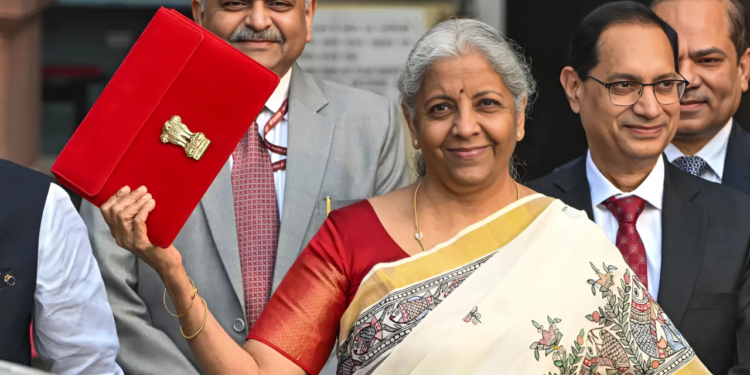Budget 2025 offers big tax relief for salaried employees. The tax rebate limit under the new tax system is now ₹12 lakh, so anyone earning ₹1 lakh per month won’t have to pay any tax. The basic exemption limit has increased to ₹4 lakh, and the standard deduction ensures that those earning up to ₹12.75 lakh remain tax-free. These changes will help middle-class workers save more and have better financial flexibility.
Key Highlights:
Higher Tax Rebate: No tax on income up to ₹12 lakh (₹12.75 lakh for salaried).
Increased Exemption Limit: Basic exemption limit raised from ₹3 lakh to ₹4 lakh.
More Savings: ₹12 lakh earners save ₹80,000; ₹25 lakh earners save ₹1.1 lakh.
New Tax Slabs 2025: Lower tax rates mean reduced tax burden.
On February 1, 2025, Finance Minister Nirmala Sitharaman presented her eighth Union Budget, offering major income tax relief for the middle class. The 2025 tax system includes a higher tax-free income limit, revised tax slabs, and other benefits for salaried employees, investors, and senior citizens.

Major Income Tax Reforms in Budget 2025
- Higher Tax Exemption: The basic exemption limit has increased from ₹3 lakh to ₹4 lakh, reducing taxes for many.
- New Tax Slabs: No tax for individuals earning up to ₹12 lakh (or ₹12.75 lakh for salaried employees with the standard deduction), leaving more money in their hands.
- Bigger Tax Rebate: The rebate limit under the new tax regime has gone up from ₹7 lakh to ₹12 lakh, benefiting those earning up to ₹1 lakh per month.
The finance ministry expects these income tax benefits to cost ₹1 lakh crore in lost revenue, giving middle-class taxpayers more money to spend.
How Much Tax Can You Save?
- Income: ₹12 lakh → Save ₹80,000 (No tax to pay now!)
- Income: ₹18 lakh → Save ₹70,000 (30% less tax than before)
- Income: ₹25 lakh → Save ₹1.1 lakh (25% lower tax bill)
New Income Tax Bill 2025: Easier Tax Rules Coming Soon
The government will introduce a new Income Tax Bill in Parliament next week. This bill aims to simplify tax rules, reduce disputes, and make tax filing easier for everyone.
Impact on Investors and Mutual Funds
With more disposable income, people may invest more in mutual funds and other assets. However, the government did not bring back indexation benefits for long-term debt mutual funds, which many investors were hoping for.
Difference between exemption, deduction and rebate
Although the terms exemption, deduction, and rebate have distinct meanings under the Income Tax Act, people often use them interchangeably. However, the key difference lies in how they affect the final tax amount,” said Gupta.
He explained that the ITA broadly seeks to tax total income as per applicable rates:
An exempt income stream is completely excluded from total income and is not taxed at all.
A deduction lowers taxable income before tax is calculated, reducing the amount on which tax is applied.
A rebate works like a discount—it is applied after tax is calculated, directly reducing the final tax payable.
Gupta noted that these distinctions are not always clear-cut, as some areas of the Income Tax Act (ITA) overlap.
For example, in Budget 2025, the announcement that no tax would be payable on income up to Rs 12 lakh might seem like an exemption. However, it is actually a rebate under Section 87A of the ITA. This means that the zero-tax benefit applies only if the taxable income, after deductions under the new tax regime, is up to Rs 12 lakh.

What does exemption till Rs 12 lakh actually mean?
If an individual or HUF earns up to ₹12 lakh (excluding income taxed at special rates like capital gains on listed shares), they won’t have to pay any tax after applying the rebate under Section 87A, according to Mitesh Jain, Partner at Economic Laws Practice.
For example, if someone has:
- Total income: ₹5,50,000
- Capital gains on listed shares: ₹50,000
- Tax on normal income: ₹5,000
- Tax on capital gains: ₹6,250
- Rebate under Section 87A: ₹5,000
After applying the rebate, the final tax liability (excluding cess) would be ₹6,250.
If an individual or a Hindu Undivided Family (HUF) earns up to ₹12 lakh in income (excluding income taxed at special rates like capital gains on listed shares), the tax calculation follows regular tax slabs. However, a rebate under Section 87A reduces the final tax liability.
1: Income of ₹8,00,000
- Capital gains on listed equity shares: ₹0
- Total income: ₹8,00,000
- Tax on normal income: ₹20,000
- Rebate under Section 87A: ₹20,000
- Final tax liability (excluding cess): ₹0
2: Income of ₹11,50,000
- Capital gains on listed equity shares: ₹1,50,000
- Total income: ₹11,50,000
- Tax on normal income: ₹40,000
- Tax on special income (capital gains): ₹18,750
- Rebate under Section 87A: ₹40,000
- Final tax liability (excluding cess): ₹18,750
New Tax Regime Rates:
- Up to ₹4 lakh – No tax
- ₹4 lakh – ₹8 lakh – 5%
- ₹8 lakh – ₹12 lakh – 10%
- ₹12 lakh – ₹16 lakh – 15%
- ₹16 lakh – ₹20 lakh – 20%
- ₹20 lakh – ₹24 lakh – 25%
- Above ₹24 lakh – 30%
Disclaimer: This is an AI-generated live blog and has not been edited by Localtak staff.
Also Read……. AI designs a new glowing protein by simulating 500 million years of evolution 2025















 Categories
Categories










